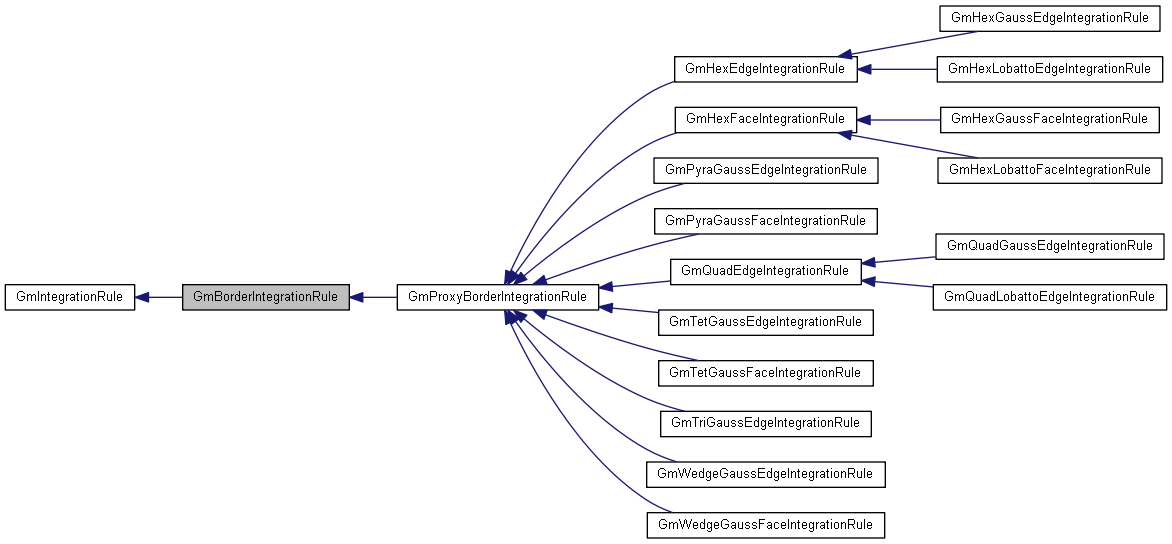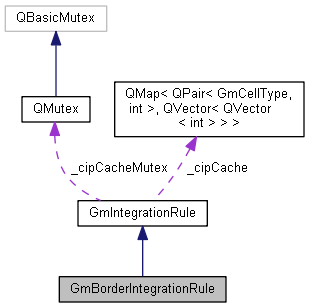 |
GemaCoreLib
The GeMA Core library
|
 |
GemaCoreLib
The GeMA Core library
|
Border integration rule base classe. More...
#include <gmBorderIntegrationRule.h>


Public Member Functions | |
| virtual bool | translatePoint (int border, const GmVector &borderCoord, GmVector &elementCoord) const =0 |
| Given an integration point calculated with the border rule, by a call to integrationPoint(), whose returned coordinate uses the border reference (edge or face), and so has less coordinates than the element coordinate system, returns a new point in the element reference system, filling the original set of coordinates with the missing, fixed, values assciated with a border. More... | |
| virtual int | numBorderCoord () const =0 |
| Returns the number of expected coordinates in a border coordinate. | |
 Public Member Functions inherited from GmIntegrationRule Public Member Functions inherited from GmIntegrationRule | |
| virtual | ~GmIntegrationRule () |
| Virtual destructor. | |
| virtual bool | isValid () const =0 |
| Returns true if this is a valid integration rule object, false if not. More... | |
| virtual int | numPoints () const =0 |
| Returns the number of integration points returned by this rule. | |
| virtual void | integrationPoint (int index, GmVector &naturalCoord, double *weight) const =0 |
| Given an index from 0 to numPoints() - 1, fills naturalCoord and weight with the position and weigth of the given integration point. More... | |
| virtual int | numNaturalCoord () const =0 |
| Returns the number of natural coordinates used by this integration rule. | |
| virtual int | degree () const =0 |
| Returns the integration degree for this rule (The polynomial degree for which this rule is exact) | |
| virtual GmIntegrationRuleType | ruleType () const =0 |
| Returns the type of the integration rule. | |
| virtual QString | ruleName () const =0 |
| Returns the current ruleName adopted by this integration rule. | |
| virtual int | rulePar (int num) const =0 |
| Returns the value of the numbered rule parameter received in the rule constructor (-1 if unused). Num should be a value between 1 and 3. | |
| virtual int | ruleParNumPoints (int num) const =0 |
| virtual int | cacheKey () const =0 |
| Returns an unique integer that can be used to uniquelly represent this kind of integration rule (i.e, two objects with the same cache key should return exactly the same set of integration points). More... | |
| virtual const QVector< int > & | closestIntegrationIndex (GmCellType type, int P, int Q, int nodeIndex) const |
| Returns a list with the index of the closest(s) integraion points from nodeIndex. More... | |
Static Public Member Functions | |
| static GmBorderIntegrationRule * | faceInstance (GmCellType type, int P, int Q, int faceType, GmIntegrationRuleType irType, int rule1=-1, int rule2=-1) |
| Instanciates a face integration rule for the specified element type using the provided parameters. Returns NULL if the parameter set results in an invalid integration rule. More... | |
| static GmBorderIntegrationRule * | edgeInstance (GmCellType type, int P, int Q, GmIntegrationRuleType irType, int rule1=-1) |
| Instanciates an edge integration rule for the specified element type using the provided parameters. Returns NULL if the parameter set results in an invalid integration rule. More... | |
 Static Public Member Functions inherited from GmIntegrationRule Static Public Member Functions inherited from GmIntegrationRule | |
| static GmIntegrationRule * | instance (GmCellType type, int P, int Q, GmIntegrationRuleType irType, int rule1=-1, int rule2=-1, int rule3=-1) |
| Instanciates an integration rule for the specified element type using the provided parameters. Returns NULL if the parameter set results in an invalid integration rule. More... | |
Additional Inherited Members | |
 Protected Member Functions inherited from GmIntegrationRule Protected Member Functions inherited from GmIntegrationRule | |
| int | makeCacheKey (GmIntegrationRuleCacheKeyBase base, bool closed, int rule1, int rule2=-1, int rule3=-1) const |
| Creates an unique cache key based on the rule type cache key and the rule parameters. | |
| QString | makeRuleName (GmIntegrationRuleType irType, int rule1, int rule2=-1, int rule3=-1) const |
| Returns a standard rule name based on rule type and rule parameters. | |
Border integration rule base classe.
A border rule is an integration rule tied to en element border, where one or more of the elements natural coordinates is fixed.
|
static |
Instanciates an edge integration rule for the specified element type using the provided parameters. Returns NULL if the parameter set results in an invalid integration rule.
Parameters P and Q are needed only when working with hierarchical element types, such as GM_HQUADP or GM_HHEXP. They can be set to 0 for "common" element types.
Obs: A call with irType == GM_AUTO_RULE_TYPE and all rules set to -1 will always succeed (unless type refers to a 1D "line" element, which can't have an associated edge rule).
|
static |
Instanciates a face integration rule for the specified element type using the provided parameters. Returns NULL if the parameter set results in an invalid integration rule.
The faceType parameter can be used to identify the desired face type for elements with more than one face type (like a wedge that has 3 quadrilateral faces and 2 triangular faces). In that case, faceType should be a GmCellFaceType value. If the element has only one face type, -1 can be passed to the faceType parameter (if the value is not -1, it MUST be equal to the type's face type).
Parameters P and Q are needed only when working with hierarchical element types, such as GM_HQUADP or GM_HHEXP. They can be set to 0 for "common" element types.
Obs: A call with irType == GM_AUTO_RULE_TYPE and all rules set to -1 will always succeed (unless type refers to an 1D "line" or 2D "surface" element, which can't have an associated face rule, or faceType references an invalid ace type for this element).
|
pure virtual |
Given an integration point calculated with the border rule, by a call to integrationPoint(), whose returned coordinate uses the border reference (edge or face), and so has less coordinates than the element coordinate system, returns a new point in the element reference system, filling the original set of coordinates with the missing, fixed, values assciated with a border.
| border | The number of the edge or face associated with the current element where the integration takes place. |
| borderCoord | The border integration point coordinate returned by the call to integrationPoint(). |
| elementCoord | The vector to be filled with element coordinates equivalent to borderCoord. After filled, elementCoord will be a vector with size equal to numNaturalCoord(), which should be equal to the number of natural coordinates of the shape function of the element that this rule will be tied to. If necessary, this function also should make sure that the domain of the natural coordinate returned is compatible with the element's shape function. |
Implemented in GmProxyBorderIntegrationRule.
 1.8.15
1.8.15